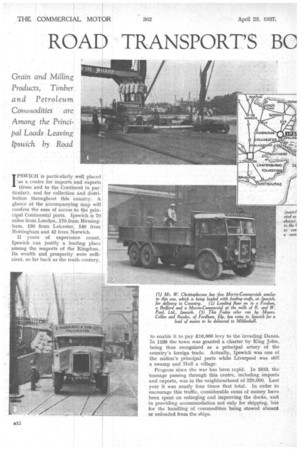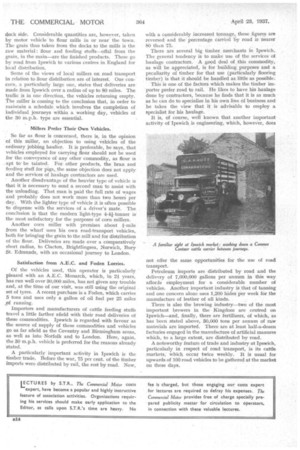RSAD TRANSPORT'S BC N TO A LEADING PORT
Page 46

Page 47

Page 48

If you've noticed an error in this article please click here to report it so we can fix it.
IPSWICH is particularly well placed ',as a centre for imports and exports (from and to the Continent in particular), and for collection and distribution throughout this country. A glance at the accompanying map will confirm the ease of access to the principal Continental ports. Ipswich is 70 miles from London, 170 frilim Birmingham, 130 from Leicester, 140 from Nottingham and 42 from Norwich.
If years of experience count, Ipswich . can justify a leading place among the seaports of the Kingdom. Its wealth and prosperity/ were sufficient, so far. back as the tenth century, to enable it to pay £10,000 levy to the invading Danes,. In 1199 the town was granted a charter by King John, being thus recognized as a principal artery of the country's foreign trade. Actually, Ipswich was one of the nation's principal ports while Liverpool was still a swamp and Hull a village. . • . .
Progress since the war has been rapid. In 1919, the tonnage passing through this centre, including imports and exports, was in the neighbourhood of 220,000. Last year it was nearly four times that total. In order to encourage this traffic, considerable sums of money have been spent on enlarging and improving the docks, and in providing accommodation not only for shipping, but for the handling of commodities being stowed aboard or unloaded from the ships. The town is of principal importance as a centre of the milling industry, as the following figures will demonstrate: In a year, a total of nearly 4,000,000 cwt. of wheat, barley and maize, valued at about £1,000,000, was imported. Maize accounted for 2,250,000 cwt., valued at £470,000; wheat, 1,250,000 cwt. (£400,000), and barley, 400,000 cwt. (£80,000).
Barely second in importance, but not, perhaps, quite of such moment so far as road transport is concerned, is the import of metallic and chemical supplies. In a year, iron pyrites totalled about 6,000 tons, valued at £7,000, and fertilizers, phosphate and lime and rock phosphate, 30,000 tons, valued at £35,000.
From the road-transport aspect, it is interesting to note that timber imports totalled 40,000 loads, valued at £126,000, petroleum products, 7,000,000 gallons (£120,000), and stone and slates about 15,009 tons (a,000). In addition, 150,000 tons of coal come into the port every year.
• It is, perhaps, the grain that creates the biggest demand for road transport. Much of the wheat is delivered to local mills and a considerable quantity of the barley to local brewers, but much of it also goes by road to London and Birmingham.
Some of the wheat makes the first stage of its journey direct by elevator from the vessel to the silos and warehouses of the mills which stand at the dock side. Considerable quantities are, however, taken by motor vehicle to flour mills in or near the town. The grain thus taken from the docks to the mills is the raw material: flour and feeding stuffs—offal from the grain, in the main—are the finished products. These go by road from Ipswich to various centres in England for local distribution.
Some of the views of local millers on road transport in relation to flour distribution are of interest. One concern, a particularly large one, states that deliveries are made from Ipswich over a radius of up to 80 miles. The traffic is in one direction, the vehicles returning empty. 'the miller is corning to the conclusion that, in order to maintain a schedule which involves the completion of individual journeys within a working day, vehicles of the 30 m.p.h. type are essential.
Millers Prefer Their Own Vehicles.
So far as flour is concerned, there is, in the opinion of this miller, an objection to using vehicles of the ordinary jobbing haulier. It is preferable, he says, that vehicles employed for carrying flour should not be used for the conveyance of any other commodity, as flour is apt to be tainted. For other products, the bran and feeding stuff for pigs, the same objection does not apply and the services of haulage contractors are used.
Another disadvantage of the heavier type of vehicle is that it is necessary to send a second man to assist with the unloading. That man is paid the full rate of wages and probably does not work more than two hours per day. With the lighter type of vehicle it is often possible to dispense with the services of a driver's mate. The conclusion is that the modern light-type 4-41-tonner is the most satisfactory for the purposes of corn millers.
Another corn miller with premises about I-mile from the wharf uses his own road-transport vehicles, both for bringing the grain to the mill and for distribution of the flour. .Deliveries are made over a comparatively short radius, to Clacton, Brightlingsea, Norwich, Bury St. Edmunds, with an occasional journey to London.
Satisfaction from A.E.C. and Foden Lorries.
Of the vehicles used, this operator is particularly pleased with an A.E.C. Monarch, which, in 21 years, has run well over 30,000 miles, has not given any trouble and, at the time of our visit, was still using the original set of tyres. A recent purchase is a Foden, which carries 5 tons and uses only a gallon of oil fuel per 25 miles „of running.
Importers and manufacturers of cattle feeding stuffs travel a little farther afield with their road deliveries of these commodities. Ipswich is regarded with favour as the source of supply of these commodities and vehicles go as far afield as the Coventry and Birmingham areas, as well as into Norfolk and to London. Here, again, the 30 m.p.h. vehicle is preferred for the reasons already stated.
A particularly important activity in Ipswich is the timber trade. Before the war, 75 per cent, of the timber imports were distributed by rail, the rest by road. Now, with a considerably increased tonnage, these figures are reversed and the percentage carried by road is nearer 80 than 75.
There are several big timber merchants in Ipswich. The general tendency is to make use of the services of haulage contractors. A good deal of this commodity, as will be appreciated, is for building purposes and a peculiarity of timber for that use (particularly flooring timber) is that it should be handled as little as possible: This is one of the factors which makes the timber importer prefer road to rail. He likes to have his haulage done by contractors, because he finds that it is as much as he can do to specialize in his own line of business and he takes the view that it is advisable to employ a specialist for his haulage.
It is, of course, well known that another important activity of Ipswich is engineering, which, however, does not offer the same opportunities for the use of road transport.
Petroleum imports are distributed by road and the delivery of 7,000,000 gallons per annum in this way affords employment for a considerable number of vehicles. Another important industry is that of tanning and one concern alone uses 1,200 hides per week for the manufacture of leather of all kinds.
There is also the brewing industry—two of the most important brewers in the Kingdom are centred on Ipswich—and, finally, there are fertilizers, of which, as has been stated above, 30,000 tons per annum of raw materials are imported. There are at least half-a-dozen factories engaged in the manufacture of artificial manures which, to a large extent, are distributed by road.
A noteworthy feature of trade and industry at Ipswich, particularly in respect of road transport, is its cattle markets, which occur twice weekly. It is usual for upwards of 100 road vehicles to be gathered at the market on these days.




























































































